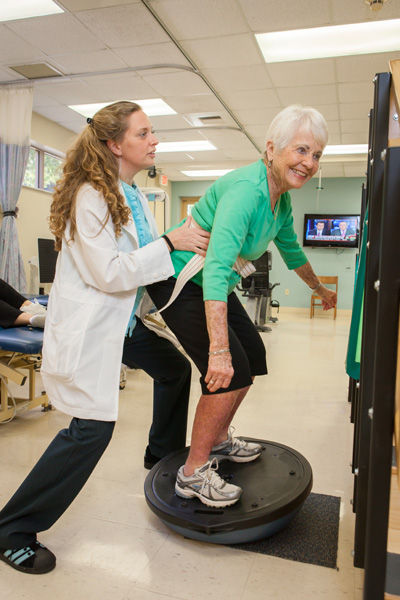According to the Centers for Disease Control, more than 2.5 million people over the age of 65 will be treated in hospital emergency rooms for falls this year, and nearly 24,000 seniors will die after taking a tumble in their bedroom, bathroom, living room or yards. In fact, falls have become the No. 1 cause of injury-related deaths among the elderly.
Marieke Dam, a physical therapist at Indian River Medical Center for the past nine years, knows the statistics but she also says she’s seeing a very clever shift in the way Vero area seniors view the problem of falling.
“About a year ago,” explains Dam, “we mostly saw patients with balance disorders after something happened.” For example, Dam continues, “if they’d fallen and fractured something, they came to the hospital and they had surgery and then they came in for physical therapy.”
“Today we’re seeing patients who are much more proactive,” the Netherlands native says. Seniors, she claims, are now coming in for physical therapy as a form of preventative medicine, taking steps now to avoid falls later.
The Mayo Clinic says the musculoskeletal system, (muscles, bones and joints), along with the visual senses, hearing, central nervous system and cardiovascular system must all be working together in order to maintain normal balance. A customized course of physical therapy, says Dam, can help keep all the cylinders firing.
“You have to look at the individual,” Dam says, “You have to look at their lifestyle and incorporate the activities of their daily living,” to develop a successful balance improvement plan, which is what more and more Vero seniors are seeking.
The National Institutes of Health says seniors are prone to a variety of ailments that can affect balance but Dam claims that when working with a physician (a neurologist or an orthopedist for example) and a good physical therapist can help seniors regain the muscle strength and joint mobility they need to help overcome balance problems.
But restoring good balance is not always an easy puzzle to piece together.
Cataracts, glaucoma, diabetic retinopathy and macular degeneration, for example, all affect a person’s vision and vision is one part of that balance puzzle. Similarly, illnesses such as diabetic neuropathy can wreak havoc with a person’s sense of the positioning of their feet and legs.
Normal age-related degeneration of the vestibular system, (the part of the inner ear that controls motion, equilibrium and spatial orientation), can also adversely affect a person’s ability to maintain balance. Unfortunately, in many cases, the medications used to treat degeneration of the vestibular system can also increase a senior citizen’s chances of falling unless preventative steps are taken.
Still, the risks of doing nothing are brutally clear. The Vestibular Disorders Association points out that between 12 and 67 percent of elderly adults who fracture a hip die within one year.
Sounding more like an impassioned college football coach than a woman with a master’s degree in physical therapy, Dam’s advice is simple: “If there’s a (balance) problem, attack it. Be proactive. The more sedentary you become, the worse your balance problems will get.”
Another form of preventative treatment, according to Dam, is “adult-proofing” the home. “I look at bedrooms and bathrooms first,” explains Dam. She asks seniors to be sure phone cords, lamp cords, stereo wires and such are never in the path of someone getting up in the small hours of the morning to walk to the bathroom.
Light is another important factor. Many seniors try to make that walk in the dark so as not to wake their spouse and that, she says, is a big mistake. Dam implores seniors to, at the very least, keep a flashlight on their nightstand or use a nightlight so they don’t trip over something and fall, and if a walker or cane is available don’t be so vain as to try to get along without it.
Installing bars and rails in bathrooms is another project she highly recommends. Any competent contractor or condominium manager, Dam exclaims, knows what’s required. A standard towel rack simply is not a viable alternative to preventing bathroom falls.
Symptoms of an oncoming or existing balance problem might include a sense of lightheadedness or disorientation or a mild-to-violent spinning sensation. Walking with a slight or pronounced stagger or having difficulty standing after sitting on a chair or sofa can also be signs, as can having difficulty climbing stairs or even being unsteady on your feet while walking across gravel or grass.
A thorough evaluation by a physician is necessary to help sort out the different causes – and possible solutions – to balance problems but the sooner those problems are addressed, the less likely someone is to become one of those 2.5 million seniors seen in hospital emergency rooms after falling. Or worse.
A typical course of PT with Dam might last four to six weeks with two outpatient visits a week as well as “take home” exercises to help with muscle strength and joint mobility.
The Indian River Medical Center’s rehabilitation therapy center is just past the main entrance to the hospital at 1000 36th Street. The phone number is 772-563-4651.

